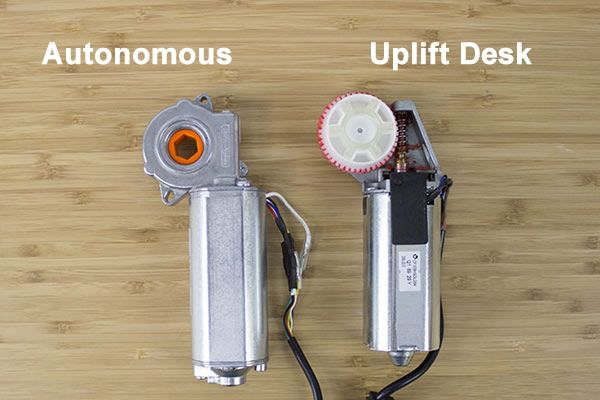
Today we will be taking a look at two popular standing desk brands, The Autonomous SmartDesk Pro and The Uplift Desk. Each brand has found a sweet spot in the low to mid-range of the electric standing desk category. While the Uplift Desk has the advantage with weight capacity and warranty coverage, it comes at an additional cost. The Autonomous isn’t a slouch though. With a capacity around 300 lbs., it also has the fastest lifting speed we have tested to date. Let’s take at both desks and see how they compare.
Need help? Get our Free Electric Standing Desk Buying Guide!
Full Disclaimer: We are an office furniture dealer and sell some of the products we review. To learn more about the products we sell, our review process and why you can trust us, please visit: Why we’re different. Who is BTOD.com and The Breakroom Blog?
Autonomous SmartDesk Pro vs Uplift Desk
– OEM Manufacturer
– Where Are Components Made?
– Pricing
– Assembly
– Specs / Features
– Stability
– Electronics
– Weight Capacity Testing
– Motors / Gears / Glides
– Frame and Feet
– How They Operate
– Return Policy and Warranty
– Bottom Line
OEM Manufacturer
Had we compared these two bands in 2015, we would have actually been comparing two frames from JieCang Linear, the current OEM for Uplift Desk. Since their initial Kickstarter and Indiegogo launch, Autonomous has switched to Aoke Furniture. Aoke has been in business since 2012 and is based in the harbor town of Ningbo. Aoke currently manufacturers their frame components while using TiMotion for all of their electronic components.
As mentioned above, Uplift Desk is currently manufactured by JieCang Linear Technology. Uplift Desk has been partners with JieCang since the inception of the Uplift Desk brand in 2013. JieCang has been producing linear actuators for hospital beds and accessories since early 2000. In 2011 they saw an opportunity to produce adjustable bases, using their linear actuator technology within metal desk frames. They are currently one of the leading Chinese manufacturers of electric standing desks.
Where are the components made?
| Autonomous SmartDesk Pro | Uplift Desk | |
| Frame | China | China |
| Electronics | China | China |
| Gears | China | China |
| Assembly | China | China |
2022 Pricing
| Autonomous SmartDesk Pro | Uplift Desk | |
| Frame Only (no top) | $599 | $549 |
| 30″ x 60″ Laminate | n/a | $769 |
| 30″ x 60″ Bamboo | $849 (53″ x 29″) | $859 |
| 30″ x 60″ Powder Coated | $699 (53″ x 29″) | $809 |
| 30″ x 60″ Hardwood | n/a | $1,439 |
| Lead Time | 2-3 Business Days | 1-2 Business Days |
| Where to buy | Buy Autonomous on Amazon | Buy Uplift on Amazon |
Assembly
The assembly process for each desk was straightforward, with only a couple minor pain points. Overall, the assembly should take most users about 30-90 minutes, depending on your skill level. I did like the way that the Autonomous Desk had separated all of the hardware, putting each type into its own labeled bag. This made the process of locating each type and following the directions easy. The way that each of the desks went together was very similar actually. Each had similar pain points when inserting hardware into the upper frame because of the awkward access to the screw holes. One thing that I found odd with the Autonomous Desk was their rubber dampeners, designed to go between the frame and desktop. Because there wasn’t a hole through the dampener, you weren’t able to line up the pre-drilled holes on the desktop. This made the process a bit of a guessing game.
Standard Specs/Features (Frame Only)
| Autonomous SmartDesk Pro | Uplift Desk | |
| Button Options | Standard four preset programmable button | Standard up/down push button |
| Lifting Capacity | 300lbs | 355lbs |
| Motor(s) | Dual | Single |
| Adjustment Range | 23” to 50” (no top) | 24.5” to 50” (no top) |
| Adjustment Speed | 2.09” per second | 1.33” per second |
| Soft Start – Stop | Yes | Yes |
| Auto-dark LED Display | Yes | Yes (programmable upgrade) |
| Leveling Glides | .5” adjustment | .5” adjustment |
| Expandable Frame | 42” to 72” wide | 42.25” to 70” wide |
| Anti-collision | Yes | Yes |
| Overload Protection | No | Yes |
| Frame Material | Steel | Steel |
| Foot Material | Steel | Aluminum |
Electronics Comparison
Both the Autonomous Desk and Uplift Desk are utilizing smart control box systems. The Autonomous Desk (Business Edition) comes standard with the programmable switch. The Uplift Desk comes standard with an basic up and down switch, with the option to upgrade to their programmable switch.

The electronics pack on the current Autonomous Desk is manufactured by TiMotion in China. We had a fairly long relationship with TiMotion, using two versions of their electronics packs. Unfortunately, our experience wasn’t a very good one and I can’t recommend using their products. While the up/down switch on the VertDesk v1 was different, the control box was the same.
The electronics pack on the Uplift Desk come from JieCang Linear Technology. They are currently manufactured in China. Overall, I would give a slight edge to the electronics found on the Uplift Desk, knowing the issues we’ve had with TiMotion. They come with a seven year warranty vs. the five year warranty on the Autonomous Desk as well. I would expect this warranty will be required from both brands at some point during ownership.
Weight Capacities and Testing
The Autonomous Desk comes with a dual motor system, which is powered by TiMotion motors. The Uplift Desk also comes standard with a dual motor system, which is powered by Shenzhen Weizhen Motor Co., LTD.
Note: We have had issues with our TiMotion motors in the past. Specifically encoder issues, which would error out and cause the desk to require a full reset. Fortunately, this was not a situation where the desk wouldn’t function again. It did become an annoyance for customers having to lower their desk to the absolute bottom position to recalibrate itself.
Motor Comparisons
Taking both of the desk columns completely apart, I was able to further inspect the internal motors. Each had strong motors, based on the testing performed, but the Uplift Desk had a clear edge.
At closer inspection of the TiMotion, I have to say that the Autonomous Desk has done well with their attention to detail of the motor. This comes as no surprise, as they have always done a good job making things appear that they are nicer than what they really are. With a fully enclosed motor, including an internalized worm drive, they have reduced the potential for contaminants to enter into their motors.

The UpLift Desk hasn’t done quite as well with their attention to detail. While the actual motor itself appears to be well built, their worm drive and gear is fully exposed. Top that off with an over lubrication issue and their motor is ripe for issues with potential dirt and dust contaminants. Over time these contaminants can reduce the the worm drives efficiency and potentially cause the motor to fail.

Gear Comparisons
Looking at both of these gears, it is fairly obvious which has the better fit and finish. The Autonomous Desk has a two stage gear that is very similar to one of the high end Ketterer gears. While the gear is lower quality than Ketterer’s, including how smoothly it adjusts, it is head and shoulders above the JieCang gear system in the Uplift Desk.

The Uplift Desk gears system is also a two stage system, which includes more plastic parts and exposed gear. In my opinion, these plastic parts are the weak point of what otherwise appears to be a strong gear. Over lubrication issues exist, with multiple types of lubricants visible on the gear. While these over lubrication issues don’t necessarily mean the gear will fail, it does have the opportunity to impact its efficiency. Overall, there is a clear lack of attention to detail here with the Uplift Desks quality control.

Glide Comparisons
Overall, both products glide systems were sub-par. With cheap plastic parts and a below average fit between each of the desks columns, both the Autonomous and Uplift had play within their columns. Having high quality glide systems is important for two reasons. First, they provide stability by creating a proper fit between different size columns. Second, the plastic glides act as a lubricant, allowing the columns to slide smoothly when in transition. Over time, cheaper glides will wear down faster than higher quality alternatives. This will only exaggerate stability issues as the play within each columns increases.

One of the first things I noticed when looking at the Autonomous Desk’s glide system was the lack of lubricant being used. This created a much cleaner experience, with the Autonomous Desk columns not seeing a build-up of lubricant like JieCang columns. When the columns were extended half way and beyond, there was a good amount of play within each of the columns. While the system used for the Autonomous Glides was very similar to the Uplift Desk, the Autonomous used one type of plastic and the glides themselves were much smaller.


The Uplift Desk, like all other JieCang columns, had over lubrication issues for their glides. One thing that I found interesting was that while there was clear over lubrication, I had also found dry spots. Based on my experience with four different brands using JieCang columns, I have always assumed the excessive lubrication was required for smooth operation over the lifecycle of the columns. If that is the case, the inconsistencies of lubrication through the glide system could become a real issue for owners of the JieCang products. We have plans to cycle test all four major players using the JieCang technology (Uplift, Jarvis Desk, GeekDesk and EvoDesk). This will give us a better idea how these types of inconsistencies impact each columns lifecycle.


Frame and Foot Comparison
The design and construction of each desks upper frame system was very similar. As you moved down the columns and to the foot, there were significant differences between each product.
The Autonomous Desk used a traditional column setup, big on the bottom and small on the top. This design typically helps reduce the front to back rocking motion found on standing desks. Their foot design provides a fairly sleek and flat look, made from heavy steel. They are currently using a paint that provides a bit of a sheen. Overall, the paint finish was good and I found it to be consistent through the entire leg/foot.
One thing that could be improved within the foot design, was how the adjustable glides attach to the foot. They have decided to cut a corner, but tapping out the bottom of the steel to create the threading to attach the glides. By doing this, they have created a below average connection, with only three lines of threading to attach the glide. A better solution would have been to use a threaded rivnut, allowing for a better connection. After all, this is the foundation of the desk, stability problems here will only be exaggerated as the desk raises up.

The Uplift Desk used a non-traditional column set up, with the smallest portion on the bottom and the largest on the top. While this will typically be less stable with rocking motions, it allowed manufacturers to add a wedge system between the motor box and upper column. Adding this wedge improved the left to right stability of the desk. Overall, the paint finish was consistent throughout the columns. The Uplift Desk used a molded aluminum foot, which is a nice alternative to the steel foot on the Autonomous desk. By doing this, they have also created a better connection with their adjustable glides.
Note: Because both the Autonomous Desk and Uplift Desk are using four screws to attach their feet to the columns, there is potential for the connection to loosen over time. We have found that as the desk moves up and down, or if you move the desk around, these will require retightening. We recommend using a gel like Loctite to create a more consistent connection.
Stability of Each Desk
One of the most important aspects of any standing desk is stability. Having a standing desk that wobbles left to right, or rocks front to back, will create distractions throughout your day. These distractions are likely to reduce your overall work efficiency. See our top 6 reasons why standing desks wobble post for more information.
Autonomous Stability Testing
Uplift Desk Stability Testing
Note: Regardless of the electric standing desk selected, it is important to always fully tighten the hardware. Without proper assembly, all standing desks will have stability issues when extended.
How Do They Operate
Both the Autonomous Desk and Uplift Desk utilize a soft start and stop mechanism, with collision avoidance. We tested each product and they both functioned properly. While in motion, each desk operated between 55-60 decibels, depending on what load was on the desk. Overall, I would say that they each have smooth movements.
One thing we found during our Uplift Desk review was that the desk stayed in motion for about .5 seconds after the button was released. This also happened with the other Jiecang products, including the Jarvis Desk by Fully. The Autonomous Desk stopped when the button was released.
The Autonomous Desk and Uplift Desk each included a one touch memory system that allowed you to select a height and release the button. The desk will move to the preset height and stop.
Frame Colors
Both Autonomous SmartDesk and Uplift Desk are available in three different frame finished options. They include: silver, black and white.
Optional Upgrades
| Autonomous SmartDesk Pro | Uplift Desk | |
| Programmable Button | Standard | $34 |
| Grommet | Included | $39 single/$69 pair |
| Locking Casters | n/a | $29/set |
| Wire Management Kit | $21 | Up to $69 with power strip |
Return Policy
| Autonomous SmartDesk Pro | Uplift Desk |
| The Autonomous SmartDesk Pro’s are returnable with no restocking fees for up to 30 days. Autonomous covers the return shipping cost. Must be returned in the original packaging in “like new” condition. | 30 day money back with free returns. Special exclusions for certain tops. |
Warranty
| Autonomous SmartDesk Pro | Uplift Desk |
| 5 warranty for electronics, which includes switch, motors and control box. The Autonomous worksurfaces are covered for 1 year. | 15 year warranty for everything. |
Bottom Line
After getting a chance to put each of these desks side by side, there are some fairly obvious differences. The Autonomous Desk was the current low price leader, but their prices are much closer to Uplift Desk as of late. Autonomous has the fastest adjustment speed I have tested to date, with an adjustment range that is the same as Uplift Desk. The stability issues on the Autonomous Desk and low quality TiMotion electronics could be a issue for some users.
The Uplift Desk has a lot to offer. With a strong lifting capacity and 15 year warranty on everything, Uplift Desk has done a good creating value. Unfortunately, shortcomings with quality through the internal components, including the gear and glide systems could be a problem in my opinion.
While no desk I have tested to date has provided me with a perfect experience, there is likely something for everyone within each of these two desks. Unfortunately, attention to some key details like quality control and overall stability are missed. Hopefully my comparison will help you make a better buying decision.








